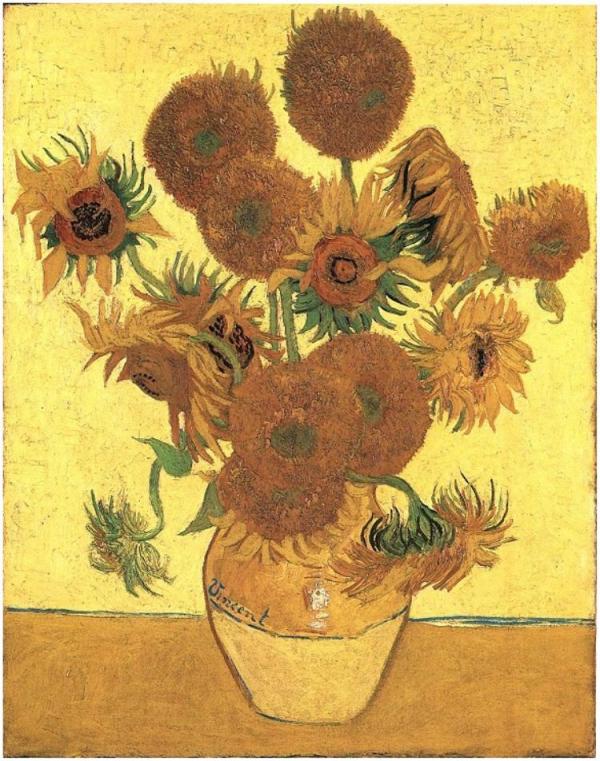Vincent Van Gogh is a legendary Dutch artist known for his post-impressionist style of painting. He created his famous series of paintings of sunflowers in the late 1880s while he was living in Arles, France. Van Gogh was fascinated by the vibrant colors and patterns of the sunflowers, and he aimed to create a series of paintings that would capture their unique beauty. The sunflowers are now considered to be some of his most iconic paintings, and they continue to inspire and captivate art lovers around the world.

In total, Van Gogh painted five series of sunflower paintings, each with a varying number of pieces. The most famous of these series is the group of seven paintings that he created in Arles, France in 1888. These paintings depict sunflowers in various stages of life, from freshly picked blooms to wilting flowers. Van Gogh’s use of bold colors and thick brushstrokes in these paintings helped to establish him as one of the most influential artists of the 19th century, and his sunflower paintings remain some of his most iconic works today.
Significance of Vincent Van Gogh’s artwork “Sunflowers”
Vincent Van Gogh’s artwork “Sunflowers” is significant for several reasons:
- It is one of his most famous and recognizable works of art, showcasing his unique style and use of color.
- The painting is a symbol of friendship, as Van Gogh created a series of sunflower paintings to decorate the room of his friend and fellow artist, Paul Gauguin.
- The sunflowers themselves are a symbol of happiness, optimism, and the beauty of nature.
- The painting has been interpreted as a representation of Van Gogh’s own search for meaning and purpose in life, as he struggled with mental illness and a sense of isolation.
- “Sunflowers” has inspired countless artists and art enthusiasts over the years, and remains a beloved and iconic masterpiece of the art world.
Van Gogh’s Sunflowers
Vincent van Gogh’s “Sunflowers” is a series of oil paintings that he produced in 1888 and 1889. The paintings depict several sunflowers in a vase, and Van Gogh used bold colors and thick brushstrokes to create a textured surface. Van Gogh’s “Sunflowers” series is a vibrant and expressive representation of his gratitude and friendship towards his fellow artist Paul Gauguin, while also symbolizing the power of nature and the artist’s emotional intensity.
Historical context of the artwork
Van Gogh painted the “Sunflowers” series during his time in Arles, France, where he hoped to establish an artists’ colony. The series was painted in anticipation of the arrival of his friend, the artist Paul Gauguin. Van Gogh wanted to decorate the “Yellow House,” where he and Gauguin would live and work together, with these paintings.
Symbolism and meaning behind the artwork
The “Sunflowers” series is often seen as a symbol of gratitude and friendship. Van Gogh wrote to his brother, Theo, saying that he hoped the paintings would convey “gratitude” and “thanks” to his friend Gauguin. The sunflowers themselves are also symbolic, representing the sun and the life-giving power of nature. The use of bright colors and thick brushstrokes also suggests Van Gogh’s emotional intensity and his desire to express his feelings through his art.
Legacy of Van Gogh’s Sunflowers
Vincent van Gogh’s painting “Sunflowers” has left a lasting legacy in the art world. The vibrant and expressive nature of the painting has influenced countless artists and has become a symbol of the Post-Impressionist movement.
The painting’s popularity and recognition have only grown in modern times. It is now considered one of the most famous and recognizable paintings in the world, and it has become a staple of art history textbooks and museum collections around the globe.
The painting has also been widely reproduced and adapted in various forms of media. From coffee mugs to clothing, the image of the sunflowers has become a ubiquitous part of popular culture. Additionally, many artists have paid homage to van Gogh’s painting by creating their own interpretations of the sunflowers. For example, American artist Ai Weiwei created a series of porcelain sunflower seeds as a commentary on mass production and consumerism.
Van Gogh’s “Sunflowers” has had a profound impact on the art world and beyond. Its expressive and vibrant nature continues to inspire artists today, and its image remains a beloved symbol of beauty and creativity.
Van Gogh’s Life and Inspiration
Vincent van Gogh is considered one of the most influential artists of the 19th century. Van Gogh produced over 2,000 artworks, including around 900 paintings and 1,100 drawings and sketches. However, he only sold one painting during his lifetime and struggled with poverty and mental illness.
Influence of Life Experiences on his Artwork
Van Gogh’s life experiences had a profound impact on his artwork. He was deeply religious and his early works were influenced by his religious beliefs. He also had a love for nature and rural life, which is reflected in his paintings of landscapes and peasants. Van Gogh’s time spent in Paris exposed him to new artistic movements, such as impressionism and Japanese art, which influenced his style.
Connection between Mental Health and Artistic Expression
Van Gogh’s mental health struggles are well documented, and it is believed that he suffered from bipolar disorder. He experienced intense emotional highs and lows, which is reflected in his artwork. His use of bold colors and expressive brushstrokes convey his emotional state and the intensity of his feelings. His painting, Sunflowers, is a perfect example of this. The bright yellow flowers represent happiness and joy, while the dark background represents his inner turmoil.
Final Thoughts
Vincent van Gogh’s life was marked by tragedy and hardship, but he channeled his pain into creating some of the world’s most beloved and celebrated paintings. His sunflowers series is an absolute masterpiece, both in terms of artistic skill and emotional resonance, reminding us of the power of art to bring beauty and meaning to the world.
- Van Gogh created the sunflower series to decorate his home.
- Sunflowers were symbolic of gratitude to Van Gogh.
- The sunflower paintings have become a symbol of inspiration and beauty that transcends time and culture.
- The sunflowers have an eternal significance, representing happiness, hope, and the promise of a new beginning.
Van Gogh’s life and work have been a source of inspiration for many generations. His sunflowers series is one of the many expressions of his artistic genius, reminding us of the power of creativity to sustain and inspire the human spirit.


